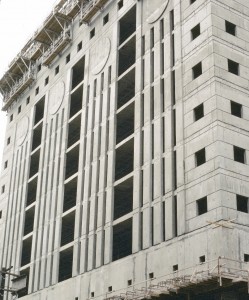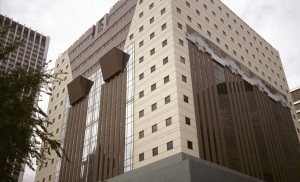Over the past week, a flurry of local and national media stories have descended on Oregon’s icon of the national postmodern architecture movement: the Portland Building. Designed by architect Michael Graves, the 15-story building has received mixed reviews by architects and occupants since its opening in 1982. According to initial reports in the Oregonian, the building is today in need of a major rehabilitation to the tune of $95 million.
Graves’ Portland Building was listed on the National Register of Historic Places in 2011 because of its exemplary significance in the development of architecture nationally. According to the nomination form:

(University of Oregon Libraries photo)
The Portland Public Service Building is one of the most notable works by internationally-known master architect Michael Graves and is widely credited as the design that established Graves’s preeminence in the field. The Portland Building itself is significant as one of a handful of high-profile building designs that defined the aesthetic of Post-Modern Classicism in the United States between the mid-1960s and the 1980s, including Charles Moore’s Piazza d’Italia in New Orleans (1978) and Philip Johnson’s AT&T Building in New York (1984), among other works. While Graves still continues to design, his current work is stylistically distinct from the architecture of this earlier period.

(University of Oregon Libraries photo)
While no decision has been made on the future of the building—or how the City would pay for a rehabilitation or replacement project—Portland’s four City Commissioners have all weighed in with their initial reactions about the difficult decisions ahead. The Mayor is currently reviewing the City’s options with decisions to be made months down the road. Among the many ideas for the building: tear it down, rehabilitate it as-is, or “retain its shell and completely reimagine everything that happens within its four walls.”

